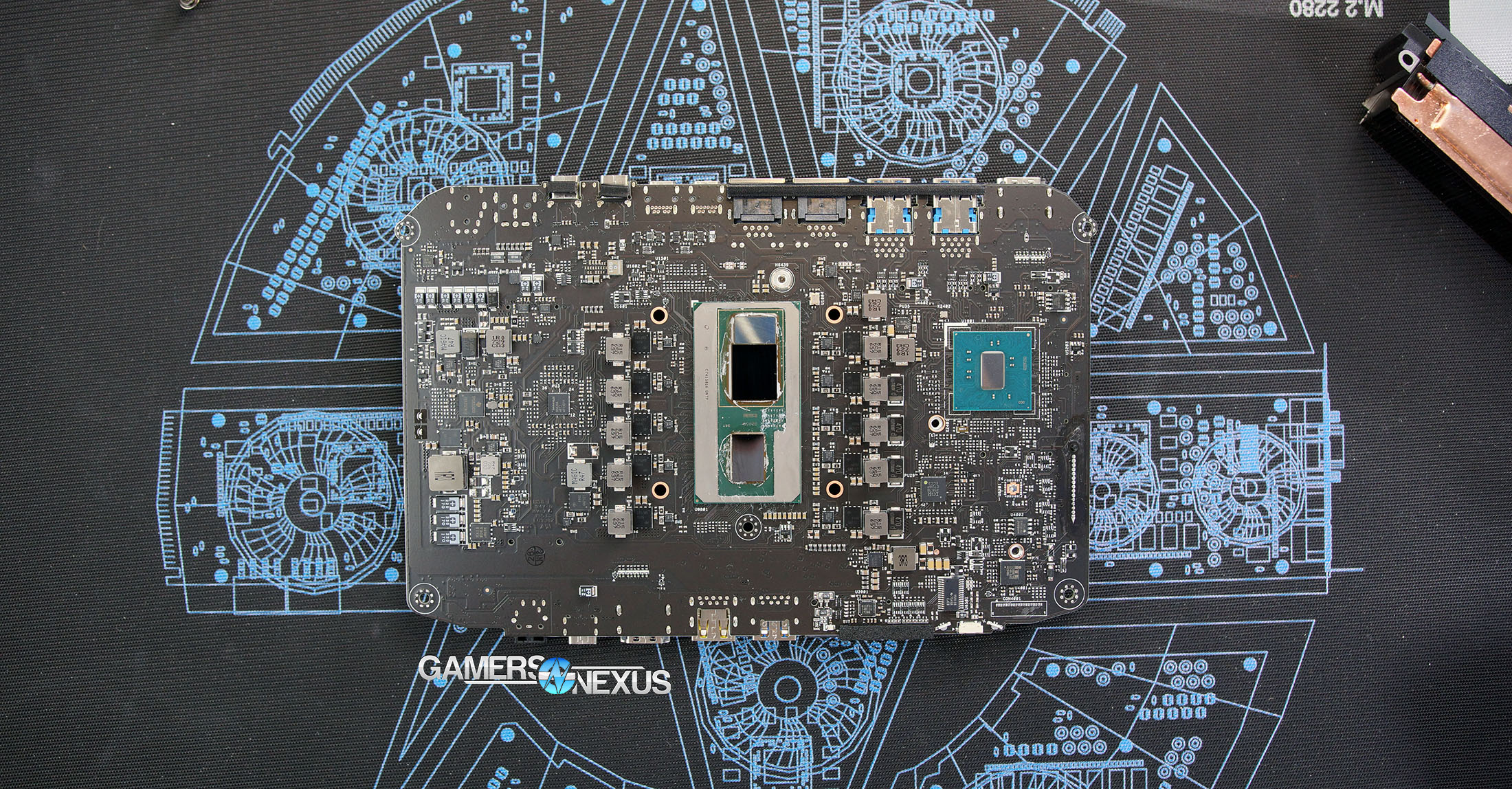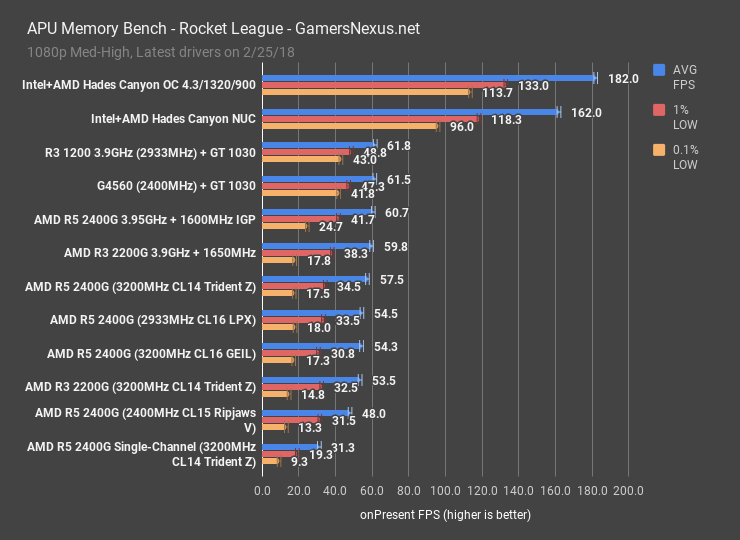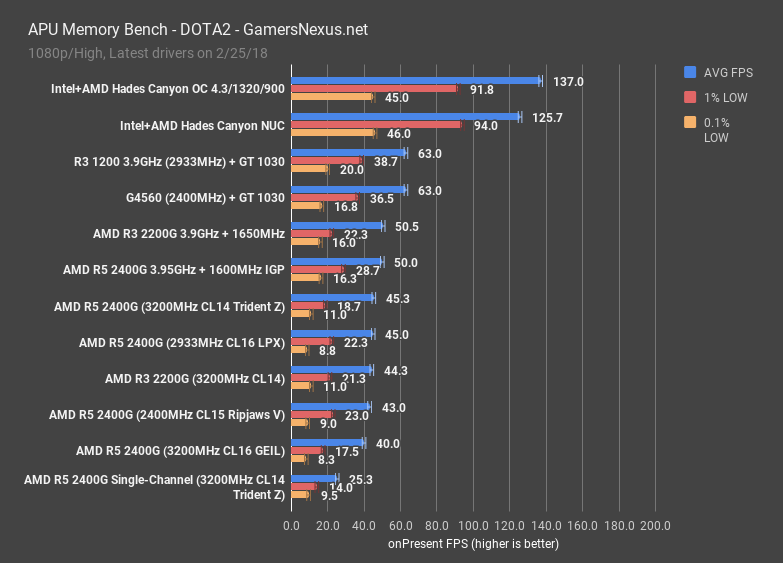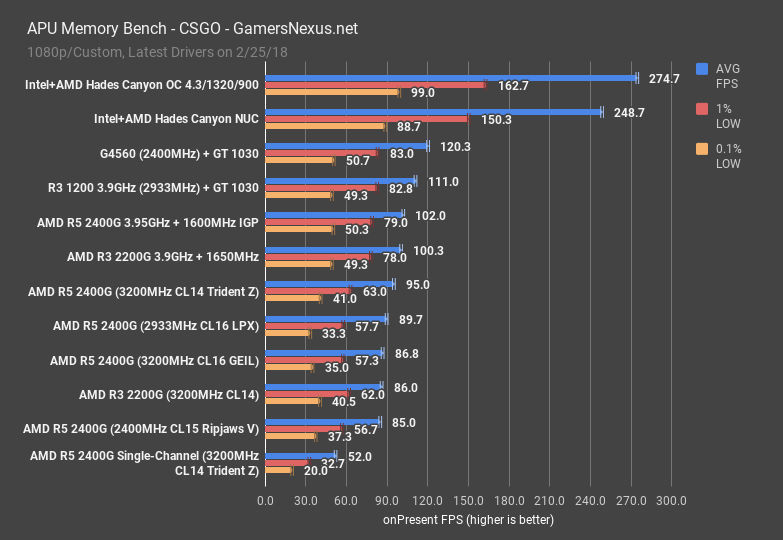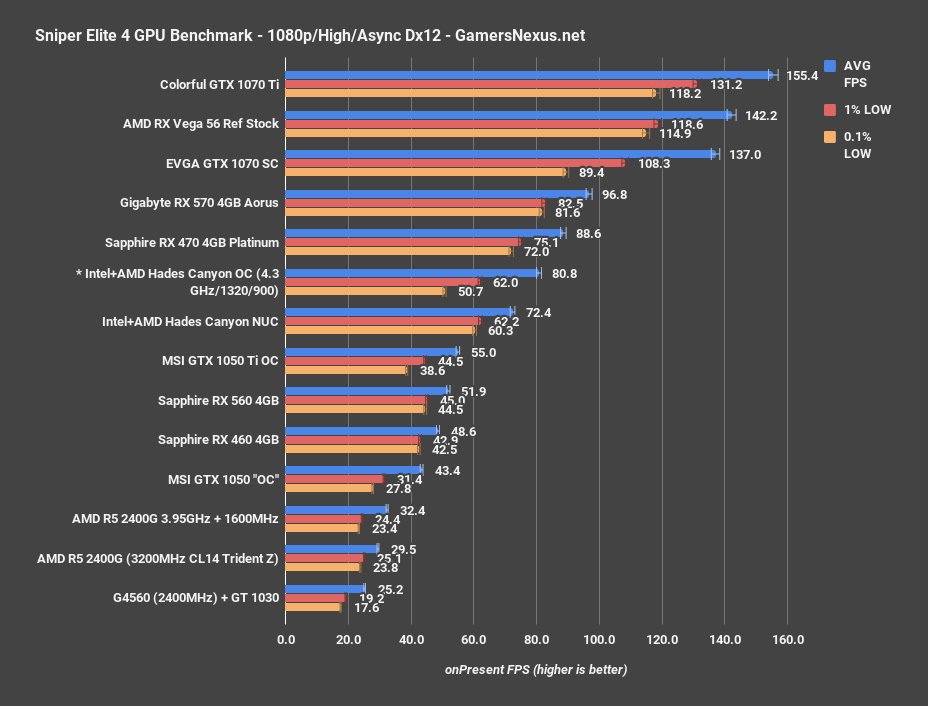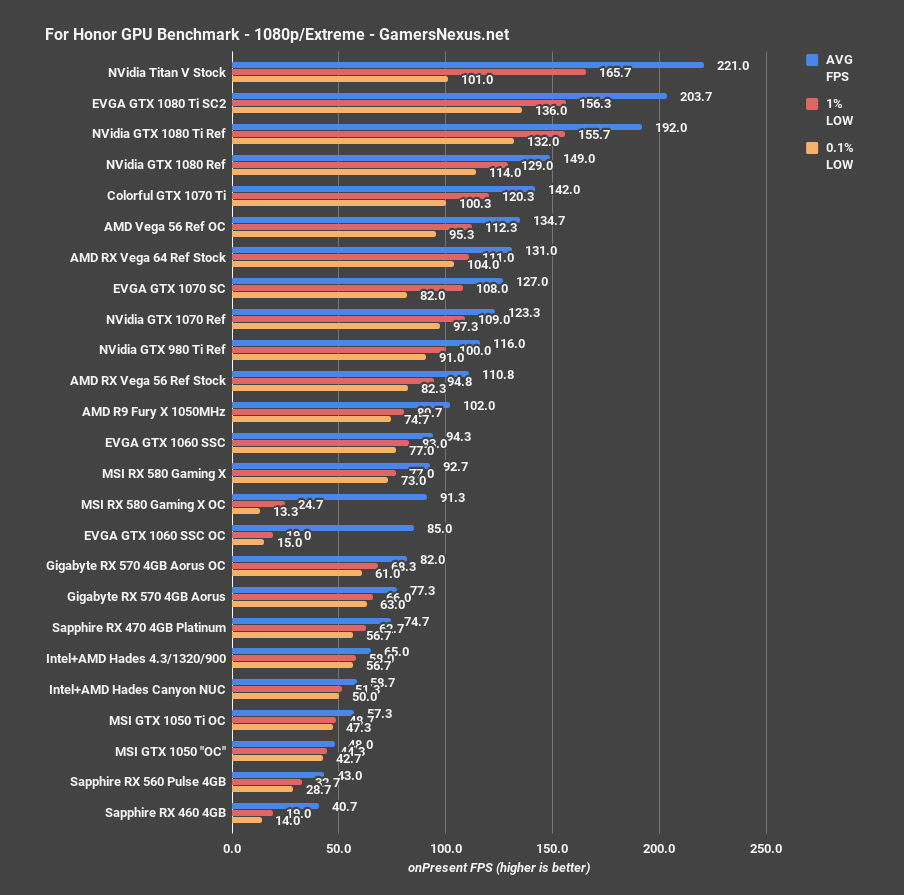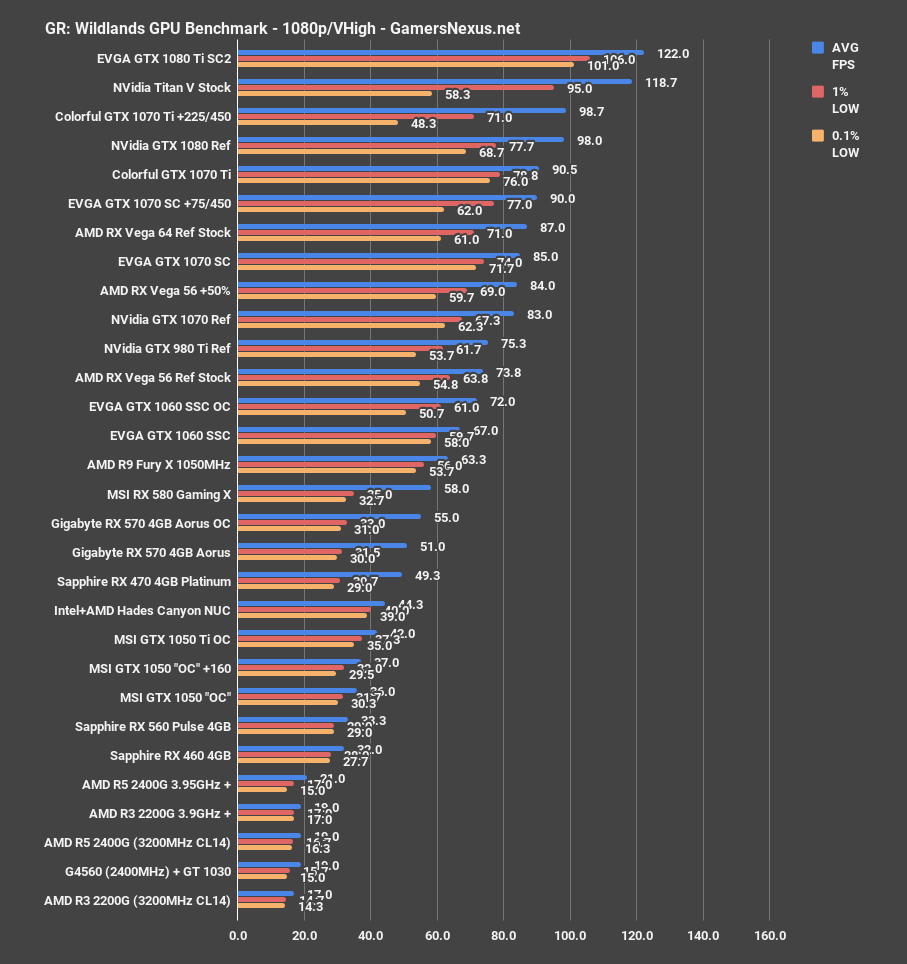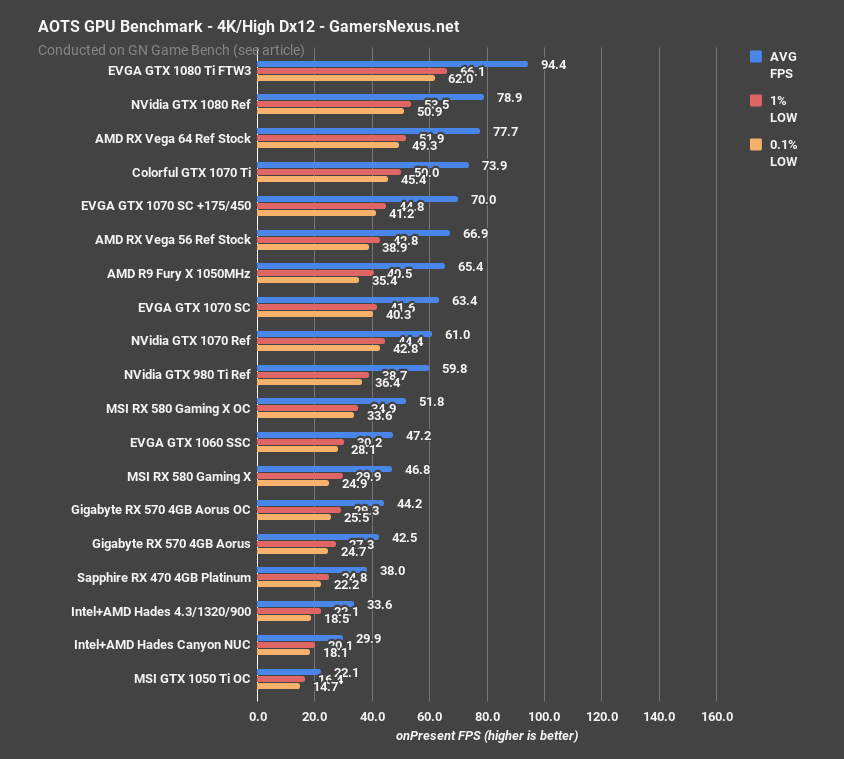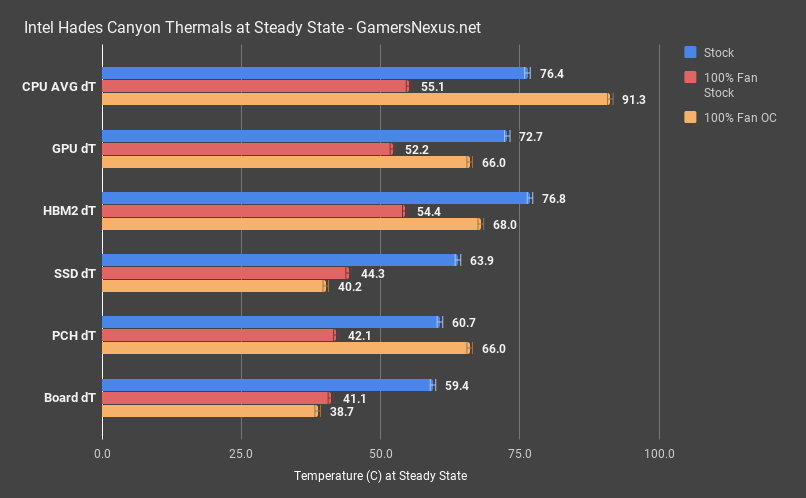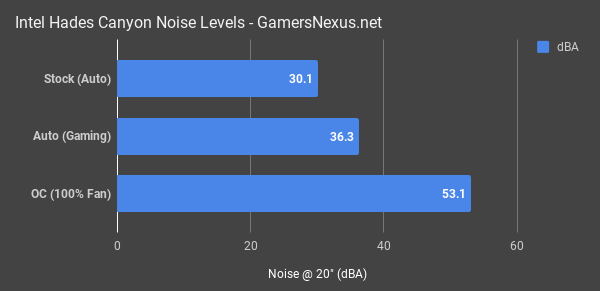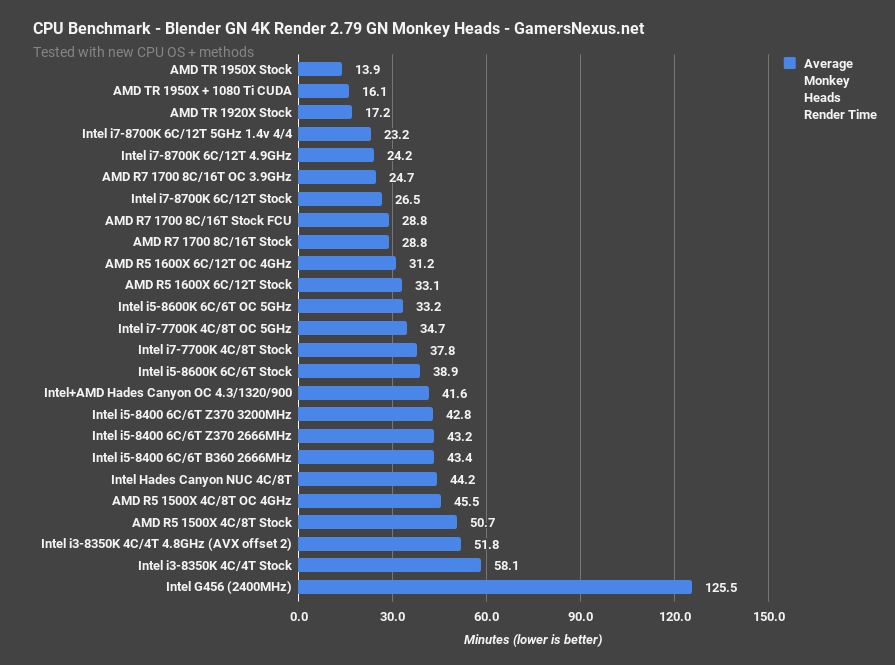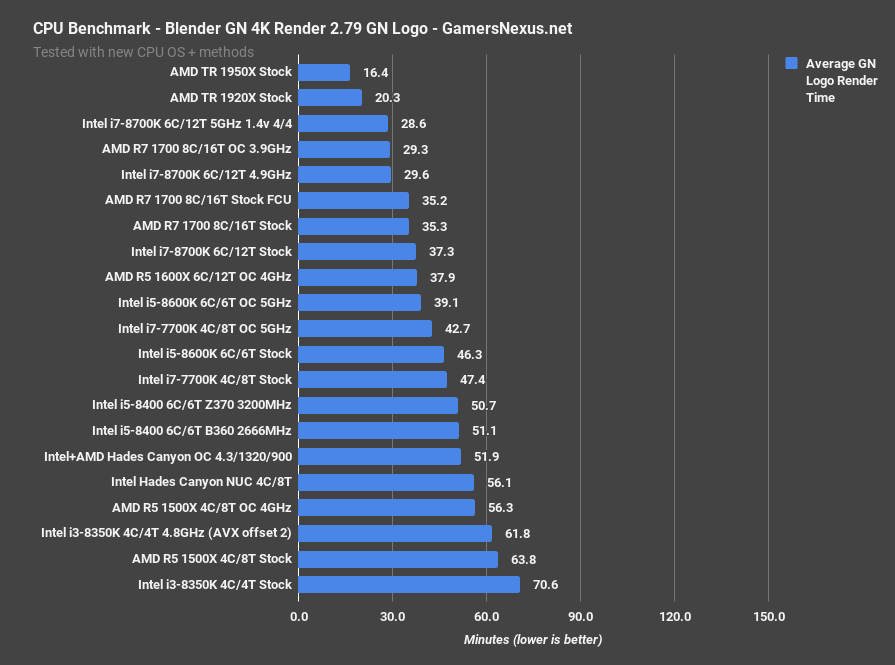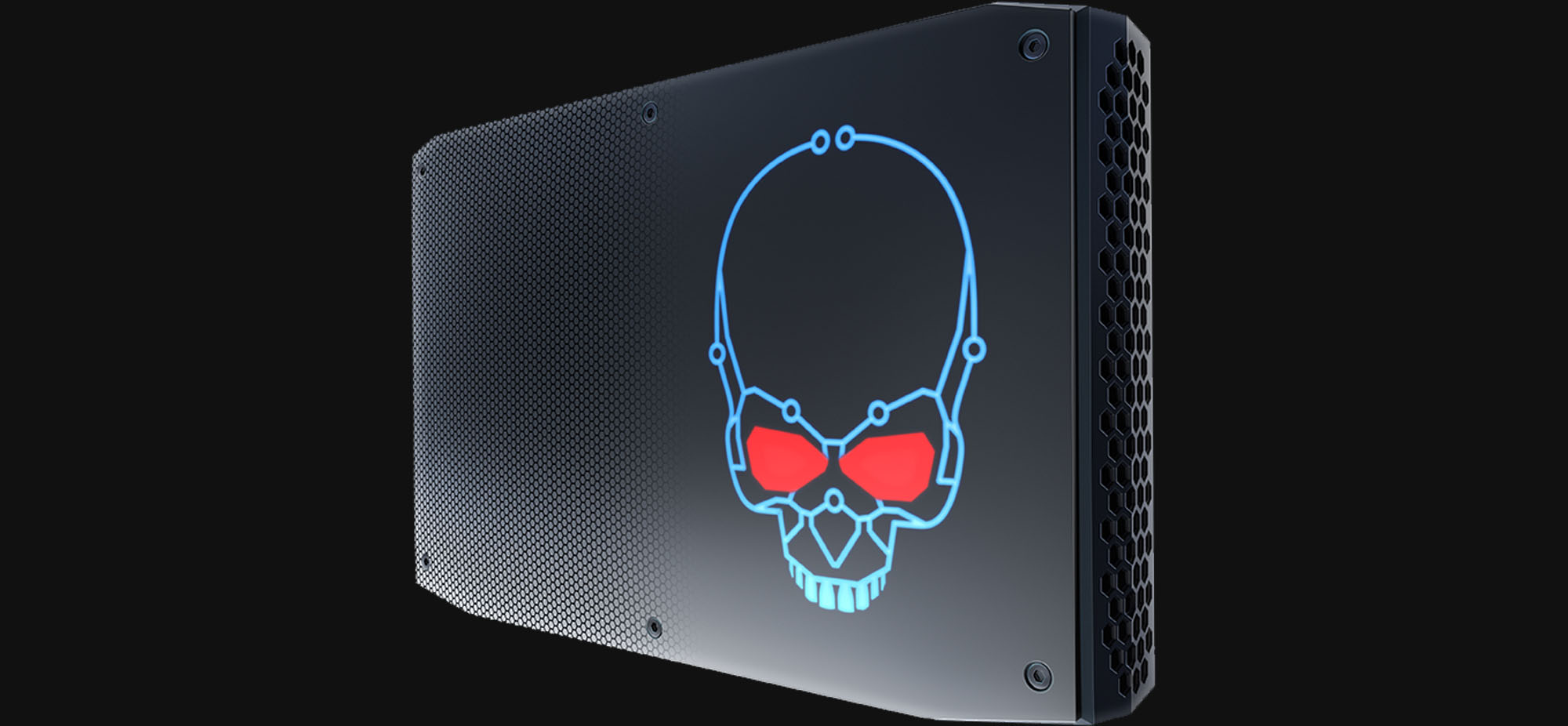Intel’s Hades Canyon NUC is well-named: It’s either a reference to hell freezing over, as AMD and Intel worked together on a product, or a reference to the combined heat of Vega and an i7 in a box that’s 8.5” x 5.5” in size. Our review of Hades Canyon looks at overclocking potential, preempting something bigger, and benchmarks the combined i7 CPU and Vega M GPU for gaming and production performance. We’re also looking at thermal performance and noise, as usual. As a unit, it’s one of the smallest, most-powerful systems on the consumer market get right now. We’ll see if it’s worth it.
There are two primary SKUs for the Intel NUC on Newegg, both coming out on April 30th. The unit which most closely resembles ours is $1000, and includes the Intel i7-8809G with 8MB of cache and a limited-core Turbo up to 4.2GHz. The CPU is unlocked for overclocking. It’s coupled with an AMD Vega M GH GPU with 4GB of high-bandwidth memory, also overclockable, but does not include memory or an SSD. You’re on your own for those, as it’s effectively a barebones kit. If you buy straight from Intel’s SimplyNUC website, the NUC8i7HVK that we reviewed comes fully-configured for $1200, including 8GB of DDR4 and a 128GB SSD with Windows 10. Not unreasonable, really.
The cheaper unit runs about $200 lower, and instead ships with the 8705G at 4.1GHz and Vega M GL graphics.
The differences are these: the higher-end unit runs 100MHz faster on a quad-core, 8-thread CPU and has a TDP of 100W instead of 65W. The Vega GPU also runs 24 Compute Units instead of 20 CUs, resulting in 1536 streaming processors versus 1280. Frequencies also change: the GPU in Vega M GH runs at 1190MHz, which we successfully overclocked to 1320MHz before hitting thermal limits. Vega M GL runs at 1011MHz. The memory interface is just 1024-bits wide, which is narrow for HBM, and results in a bandwidth of 179GB/s for Vega M GL and 205GB/s for Vega MM GH.
Those are the differences.
Low-End Gaming Benchmarks – Hades Canyon (Vega M GH & i7-8809G)
We weren’t sure what to expect for performance starting out, so we ran the NUC through our low-end component benchmarks for APUs and cheap dGPUs. We later moved to high-end testing, for reasons quickly explained.
Rocket League Benchmarks – Hades Canyon (Vega M GH & i7-8809G)
In Rocket League, we rapidly became bound by the low-end GPU for earlier GT 1030 and APU benchmarking, as illustrated by the rough 62FPS limiter. The stock Hades Canyon system operated at 162FPS AVG, several times higher in framerate than the R3 1200 and GT 1030 – we clearly needed to move to higher-end comparisons. Overclocking the NUC, despite ear-bleeding from fan noise when overclocked, netted us an impressive 12% performance uplift. That’s from a 4.3GHz all-core frequency and 1320MHz GPU frequency, with 900MHz on the HBM2.
DOTA 2 Benchmarks – Hades Canyon (Vega M GH & i7-8809G)
DOTA2 further drove this point home, again landing multiple times faster in average FPS than the next-fastest low-end components. 0.1% lows weren’t great, but that’s a limitation of DOTA2, not the NUC.
CSGO Benchmarks – Hades Canyon (Vega M GH & i7-8809G)
CSGO, finally, put the nail in the coffin. We were running nearly 300FPS average at times, well ahead of a G4560 and GT1030 combination.
Let’s move to higher-end dGPU benchmarks.
Sniper Elite (Dx12) Benchmarks – Hades Canyon (Vega M GH & i7-8809G)
Sniper Elite 4 gives us a bit of a best case for the Vega M GPU, as Vega plays well with the asynchronous compute shaders used in Sniper’s Dx12 implementation. Note that all of these dGPUs, unless otherwise stated, were tested with our old standard 7700K at 4.5GHz for GPU benchmarking. We are still GPU-bottlenecked in those cases.
The stock system lands at 72FPS AVG, with lows at 60FPS. This positions it just above a GTX 1050 Ti, with an RX 470 and 7700K and outperforming the NUC by about 22%. Overclocking the NUC pushes us to 81FPS AVG, closing that gap, and providing performance somewhere between a 1050 Ti and RX 470 or 570 when unrestrained by the CPU.
For Honor (Dx11) Benchmarks – Hades Canyon (Vega M GH & i7-8809G)
For Honor gives us a traditional Dx11 title with more software abstraction layers than Sniper Elite 4. For this one, the NUC operates at 59FPS AVG when stock, with lows at 50FPS. That puts the NUC about where a GTX 1050 Ti performs, with an RX 470 about 27% ahead with the 7700K. Overclocking the NUC pushes it to 65FPS AVG, lows scaling reasonably, for a gain of 11% over stock.
Ghost Recon (Dx11) Benchmarks – Hades Canyon (Vega M GH & i7-8809G)
Ghost Recon is another traditional Dx11 title. With Very High settings at 1080p, the Hades Canyon NUC ends up at 44FPS AVG, again just ahead of the GTX 1050 Ti and below the RX 470. The Vega M GPU and i7 do well in this game when compared to much larger discrete components.
AOTS (Dx12) Benchmarks – Hades Canyon (Vega M GH & i7-8809G)
We use Ashes of the Singularity as a synthetic benchmark, at this point, but it does give another DirectX 12 implementation to consider. For this one, we’re at 30FPS AVG for the stock NUC, or 18FPS for 0.1% lows. That puts us considerably ahead of the GTX 1050 Ti – about 35% -- and overclocking the NUC positions the stock RX 470 about 13% ahead. Again, not bad for such a small box, though it is screaming loud and burning up with our overclock.
Hades Canyon Overclocking
Overclocking Hades Canyon can be done from Intel’s UEFI (“Visual BIOS” – a name we haven’t seen since their motherboards were killed) or through XTU. Although UEFI has some basic voltage tuning and frequency options, we found no power or current limit options in UEFI for the NUC. We ended up using a mix of BIOS (for fan speed control and memory overclocking) and XTU (for multipliers, voltage, and power limits). For Vega M GPU overclocking, a reskinned WattMan can be used for volt-frequency curves and power limit uplift.
We ended up at about 4.3GHz all-core on the CPU (throttling down to 4.2GHz under prolonged multi-component loads, like Blender, where memory also burns), but needed the power limit removed. Thermal throttling limited us heavily. We could push this CPU a lot harder with an aftermarket solution. 4.2GHz would be sustainable for long-term on our box with a +0.015VCore offset.
For the GPU, we found 1320MHz to be stable, with 900MHz HBM as stable. As with Vega dGPUs, the HBM dictates scalability to a certain degree in gaming workloads. The memory overclock is important.
We pushed memory to 3200MHz, but this will obviously be contingent on the memory choice more than anything. We weren’t going for a heavy memory OC. Thermal challenges were enough to tackle with the CPU and GPU sharing a cooling solution.
Speaking of, the Hades Canyon cooling solution is simple, but high-end: Intel is using a shared aluminum finstack across the back of the unit, butted-up against two radial fans of larger size. As always with fans, a larger blower cage allows slower RPMs while pushing similar air to higher RPM, small-size fans. The end result is reduced noise at similar cooling capabilities to previous NUC fans.
Removing the cooling solution reveals that the entire underside of the cooler, the whole coldplate surface, is one massive vapor chamber. This is where a lot of the NUC’s thermal management is derived. Despite being overall limited in real estate, by using a vapor chamber and finstack against a large set of blowers, Intel is able to sink most of the power output in heat from even overclocked components – but it requires ear-bleeding fan levels. Stock, we were able to sustain completely reasonable thermal results and low noise emissions, which we’ll look at below.
Intel Hades Canyon Thermal Testing (CPU/GPU Temperature)
A box this small will inevitably become constrained thermally when under adverse conditions. With the help of some thermocouples, we collected a lot of thermal data for the stock box and stock fan curve, a 100% fan curve and stock settings, and an overclocked configuration with max fan speeds. Note that all testing was done in a controlled environment with a constant ambient temperature. Ambient was logged second-to-second, with discrepancies normalized.
Running FireStrike Extreme for 30 minutes, the stock Hades Canyon box reached steady state at about 76 degrees Celsius average core temperature. This is completely acceptable. The GPU also operated acceptably, at about 77 degrees Celsius, with the SSD at 64 degrees, PCH at 61 degrees, and motherboard at 59 degrees.
With the exact same settings but an irritating 100% fan speed, we measured roughly a 20-degree drop across the board. Intel tuned the NUC to be usable in a living room, and doesn’t blast the fan speed unnecessarily when thermals are well within control, as they were in our stock test. Regardless, this gives an idea for our headroom.
Overclocked to 4.3GHz, 1320MHz GPU, and 900MHz HBM2, we landed nearing throttle territory at 91 degrees Celsius on the CPU, with the GPU still lower than stock – but that’s because of the boosted fan speed.
Intel Hades Canyon Noise Levels
Noise was tested at our standard 20” distance with a fixed-place dBA meter. The noise floor of the room is low, at 26dBA.
When idle on desktop and with stock settings, we measured a noise output of 30dBA at 20” – not bad, and that extends to lightweight browsing. Gaming understock settings and fan curves results in a 36dBA noise level from 5 minutes to 30 minutes of play and onward, which is certainly audible, but not louder than the average game console under similar load. Maxed-out, we’re measuring 53.1dBA for the fan, but it’s a high-pitched, whining noise that resembles a leaf blower at a distance. The type of noise is irritating. Fortunately, you’ll never really encounter it unless manually configuring for a big overclock (relative to the unit), so we can’t complain too much. This isn’t something you’ll encounter under auto fan curve settings.
Blender Benchmarks – Hades Canyon
As for Blender on the CPU component, not rendering on Vega M, we measured Intel’s contribution as performing roughly equivalently to an i5-8400, which completed the GN Monkey Head render in about 43 minutes. The NUC finished in 44 minutes. Overclocking to 4.3GHz, though thermal throttling down to 4.2GHz, resulted in a 41.6 minute completion time for the NUC. That puts us between the stock Intel i5-8600K and i5-8400. For the GN logo render, we completed the process in 56 minutes stock, or 52 minutes overclocked on the Hades Canyon box. Comparatively, this is roughly equivalent to either an i5-8400 or R5 1500X at 4GHz.
Not particularly powerful on the CPU front, but that limitation is partly due to thermals – we could overclock higher if we had thermal headroom, but it just doesn’t exist in this box. Perhaps for a soon-to-come mod.
Intel Hades Canyon Conclusion: NVidia’s New Pain Point
Let’s get the non-political stuff out of the way first: We found Intel’s (and AMD’s) Hades Canyon NUC to possess incredible processing power for its form factor, particularly for gaming. Performance of the high-end unit puts it between GTX 1050 Ti and RX 470 performance levels, which is hands-down impressive for the Vega M GH unit that’s included. On a CPU level, Intel’s contribution to the unit places it between i5-8400 and i5-8600K levels of performance in production (Blender) workloads, which is also admirable for a unit with the thermal and power limitations of a NUC.
Intel’s done well with engineering its thermal solution. Although we are unfortunately limited in overclocking by thermals, it’s not unexpected – this thing is tiny, and that hot air has a hard time exhausting fast enough over a relatively low surface area. The large vapor chamber is appreciated over a standard copper coldplate and also allows Intel to keep a small form factor (no heatpipes required). Two blower fans also aid in noise levels, as the two have enough joint power to soften the fan-speed curve to a point of being completely acceptable at stock configurations. We saw idle and browsing noise levels at about 30dBA (in a noise floor of 26dBA – just barely audible at 20”), with gaming noise levels at around 36dBA-40dBA, depending. Pushing the fan to 100% is required for a big overclock to hold, at which point it becomes a leaf blower heard from the distance. We don’t recommend it. Although the unit is unlocked for overclocking, you shouldn’t expect to achieve much without either mods or mitigated OC goals.
On the political side, Hades Canyon has a lot of interesting implications for the industry. We recently commented that nVidia’s partnership with ARM (announced at GTC 2018) seemed like a stab at AMD and Intel. Intel’s partnership with AMD allows the companies to couple what each does best – Intel’s full-solution engineering and CPUs with AMD’s significantly higher-powered graphics solution. Together, the two fiercely compete with an industry largely owned by nVidia. NVidia’s SFF box partners, like Zotac with the Zbox, suddenly find themselves embroiled in a battle with two silicon makers who are out for blood. This also has implications for Kaby Lake G and Vega M in portables, like laptops, where nVidia presently holds the vast, overwhelming majority of the gaming market. Kaby Lake G and Vega M work well together. If Intel and AMD can keep the daggers behind their backs for long enough to stake some of the laptop market, nVidia will undoubtedly feel something it hasn’t felt in a long time: competition.
Editorial, Testing: Steve Burke
Video: Andrew Coleman
